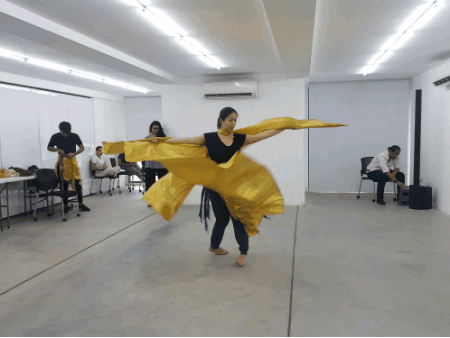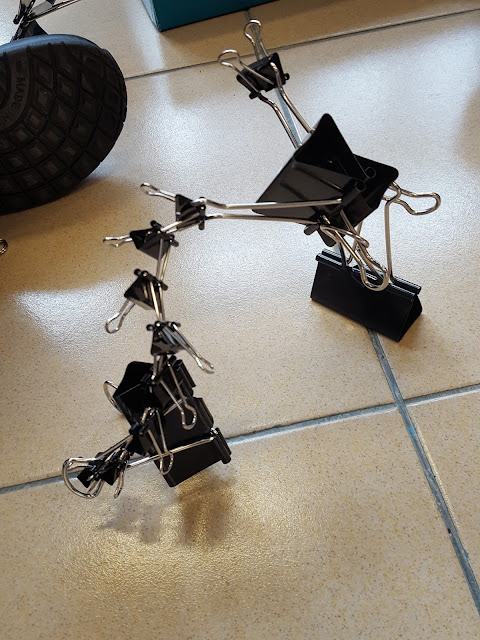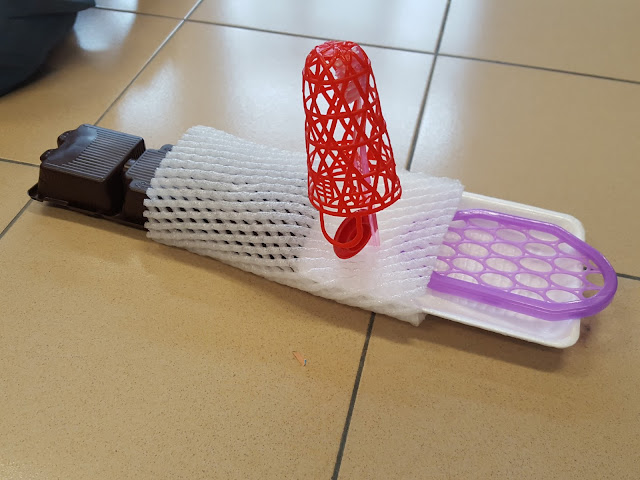My colleagues and I visited Artground for an art educator's learning journey. We saw spaces for triannual installation which children could enjoy by engaging their bodies. A few dancers giving us a teaser of what the children would experience in their drama workshop. Then we were divided into two groups with each playing the role of monkeys and kangaroos. They even had an outdoor garden and children who signed up for this workshop would learn about the environment, handle earthworms, its compost and do coffee painting.
Tabs under construction!
Thursday, February 8, 2018
Friday, February 2, 2018
Art Class: Patterns Around Us
In the lower primary Mathematics syllabus, the children have learnt about shapes and angles in the Geometry sub-strand. Revisiting these concepts about Patterns meant that lesson has to be applicable. The children looked for Patterns around the canteen. They had to spot for repeated shapes, lines and colours by sketching them. Next, we played a game in class where an image of a close up pattern of object is shown and they had to guess the object. The children also used DIY Tangrams and combine their pieces to make a bigger image.
 |
| These circular plastics were the byproducts of their school files :D |
 |
| Photo credit: Ms Candice |
Labels:
artclass,
patterns,
primarythree,
tangrams
Thursday, January 25, 2018
Art class: Finding Balance
We were into our third week of a new school term and after meeting all 5 classes of 7 years old, I have finally met my youngest "revolt" in art class. It was during the end of art lesson and the children had to line up to return to their form class. A girl pull a long face and approached me, looking slightly distressed. She mumbled a one-word syllabus under her breath which sounds like "Ar...ar...". Finally, she exclaimed, sounding frustrated "Why don't we have Art lesson yet?" I couldn't contain my laughter and told her we had just finished one. In her exact words, she replied: "That's not Art. That's a game".
The child's comment is a great reminder for me to explore breath and depth in lesson planning as contemporary artists do work with materials, methods, conepts and subjects that challenge traditional boundaries.
In these lessons, the children worked in groups to make an artwork that show "balance" with an emphasis for teamwork and collaborative skills. They used some PE equipment, binder clips, cardboards, styroform peanuts and toothpicks, and plastic packagings.
The child's comment is a great reminder for me to explore breath and depth in lesson planning as contemporary artists do work with materials, methods, conepts and subjects that challenge traditional boundaries.
In these lessons, the children worked in groups to make an artwork that show "balance" with an emphasis for teamwork and collaborative skills. They used some PE equipment, binder clips, cardboards, styroform peanuts and toothpicks, and plastic packagings.
Labels:
artclass,
balance,
binderclips,
cardboard,
PEequipment,
plastics,
primaryone,
sculpture,
styroformpeanuts
Wednesday, January 17, 2018
Housekeeping: Caring for Art Supplies
 |
| Coloured ends of markers and pens |
 |
| Mirror corners with air-dry clay |
I usually do an introduction of myself to a new cohort of students by sharing about myself in different contexts through photographs. What I am particularly fond of is to sneak in some artroom management rules as I talk. I showed the children how other children from another country lived differently. We discussed about school facilities and lifestyle inconvienence which are evident from the photos. Then we do a comparsion between their lives and the children in the photos. The point of the discussion is really for the children not to take things for granted. An explicit teaching of a hidden curriculum meant that the children are expected to cherish art supplies and prevent the stationeries' premature death. This year, I have the table corners painted to match the colours of the labelled art supplies. This labelling would prevent accidental theft and will require children to be more responsible when it comes to returning supplies to its rightful storage place.
Labels:
art supplies,
classmanagement,
housekeeping
Friday, January 12, 2018
No Rewards Art Class
It's the new year and I'm seeing 5 classes of 7, 8 and 9 years old each. Last year, I was trialing a No Rewards art class and I felt that it was very difficult for me with some classes. I did stick with what I had intended and I would do the same this year. There are a few reasons for this:
When I just started out teaching, I was a form teacher teaching the first grade. Naturally, I wanted to carry out the point system in my classroom as an incentive for having their work done, team work, good behaviour, doing the CORRECT correction etc. I gave out cow cash coupons, group points, auctions and fairy dust cards (You can view it here) Logistically, it was managable because I only had 30 pupils. Despite my efforts, I found my pupils self-centered and fiercely competitive. They were angels in my class but a terror in others.
Fast forward to present day, I no longer have the luxury of time to develop rapports with pupils as though I teach only 30 of them. Given that we meet more than 400 pupils each week and the infrequency of our interactions, knowing every pupil in a conventional way is not realistic. As an art, music or PE teacher, I think our subject matter is inherently interesting. Therefore, I insist in a no rewards classroom because coming to class is a reward by itself. That said, most of the leverage will come from the teacher and the most important area is our lessons that must somehow be noteworthy. Bribing pupils to behave in return for rewards sends the wrong message and interferes with the intrinisc value of joyful learning.
As an art teacher, I have the privilage of interacting with other teachers and by entering their classrooms, I have observed that teachers who hardly focus on external rewards have pupils who have better self-regulation skills. I do not assume that this one strategy is enough to create ready learners but for this post, I would just like to focus on this.
When I just started out teaching, I was a form teacher teaching the first grade. Naturally, I wanted to carry out the point system in my classroom as an incentive for having their work done, team work, good behaviour, doing the CORRECT correction etc. I gave out cow cash coupons, group points, auctions and fairy dust cards (You can view it here) Logistically, it was managable because I only had 30 pupils. Despite my efforts, I found my pupils self-centered and fiercely competitive. They were angels in my class but a terror in others.
Fast forward to present day, I no longer have the luxury of time to develop rapports with pupils as though I teach only 30 of them. Given that we meet more than 400 pupils each week and the infrequency of our interactions, knowing every pupil in a conventional way is not realistic. As an art, music or PE teacher, I think our subject matter is inherently interesting. Therefore, I insist in a no rewards classroom because coming to class is a reward by itself. That said, most of the leverage will come from the teacher and the most important area is our lessons that must somehow be noteworthy. Bribing pupils to behave in return for rewards sends the wrong message and interferes with the intrinisc value of joyful learning.
As an art teacher, I have the privilage of interacting with other teachers and by entering their classrooms, I have observed that teachers who hardly focus on external rewards have pupils who have better self-regulation skills. I do not assume that this one strategy is enough to create ready learners but for this post, I would just like to focus on this.
Labels:
artclass,
classmanagement,
norewards
Wednesday, December 20, 2017
Artventures: Travel writing X Illustration Mentorship
A few months ago, I responded to an open call for a travel writing and mixed- media mentorship organised by my regional library. It has since concluded and I still feel a tinge of sadness that all good things have to come to an end. Never in my wildest imagination that travel writing is considered a genre or that there are classic essays by travel writers. There is a wide disparity between real travel and tourism.
Under the tutelage of writer Dr Boey Kim Cheng and illustrator Ms Neo Anngee whom we met on alternate weeks, I have unlearnt a lot of acquired knowledge and had a fun time interacting with other participants/ writers. We read and discussed numerous examples of travel writing and their stories are still etched in my mind. Some of my favourites are, Paul Theroux's Ghost Train to Eastern Star, Eric Hansen's A Stranger in the Forest, Annie Dillard's Teaching a Stone to Talk, Bruce Chatwin's The Songlines and William Dalrymple's City of Djinns.
There were also invited guest artists and travel writers such as Pixin, Jackie and Samantha who shared about themselves and their work. I'm looking forward to read the selected essays in an anthology next year!
Under the tutelage of writer Dr Boey Kim Cheng and illustrator Ms Neo Anngee whom we met on alternate weeks, I have unlearnt a lot of acquired knowledge and had a fun time interacting with other participants/ writers. We read and discussed numerous examples of travel writing and their stories are still etched in my mind. Some of my favourites are, Paul Theroux's Ghost Train to Eastern Star, Eric Hansen's A Stranger in the Forest, Annie Dillard's Teaching a Stone to Talk, Bruce Chatwin's The Songlines and William Dalrymple's City of Djinns.
There were also invited guest artists and travel writers such as Pixin, Jackie and Samantha who shared about themselves and their work. I'm looking forward to read the selected essays in an anthology next year!
Labels:
artventures,
illustration,
travelwriting
Wednesday, November 1, 2017
Art Class: Our New School
Perhaps this lesson unit is inspired by the incessant dust settling in my art room... We read Roberto The Insect Architect by Nina Laden. This book is quite wordy for 7 years old but they should be good since I'm reading to them using my most animated voice. For children who are not ready to tackle such a book (Phew! I only have 1 in one of my classes), I have them stand beside me and using his/ her finger as a pointer as I read. This seems to cause them to be less fidgety and less likely being a disruption to the others.
The children are working on designing their new school as an architect. They have wonderful ideas during class discussion such as water slides, train tracks, trampoline, tunnels, university etc. Windows that are neither squares nor rectangular. There is even a mobile school that moves like a vehicle. Some photos of their drawings with mixed media are below:
Labels:
architect,
artbook,
artclass,
narrative,
primaryone
Subscribe to:
Comments (Atom)














































